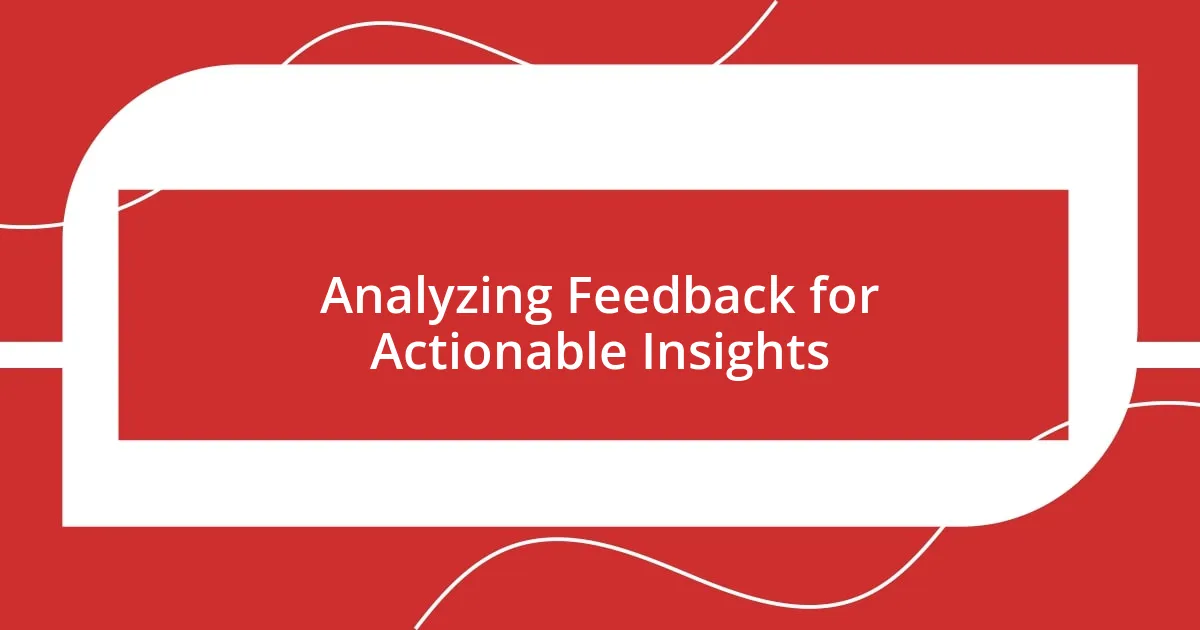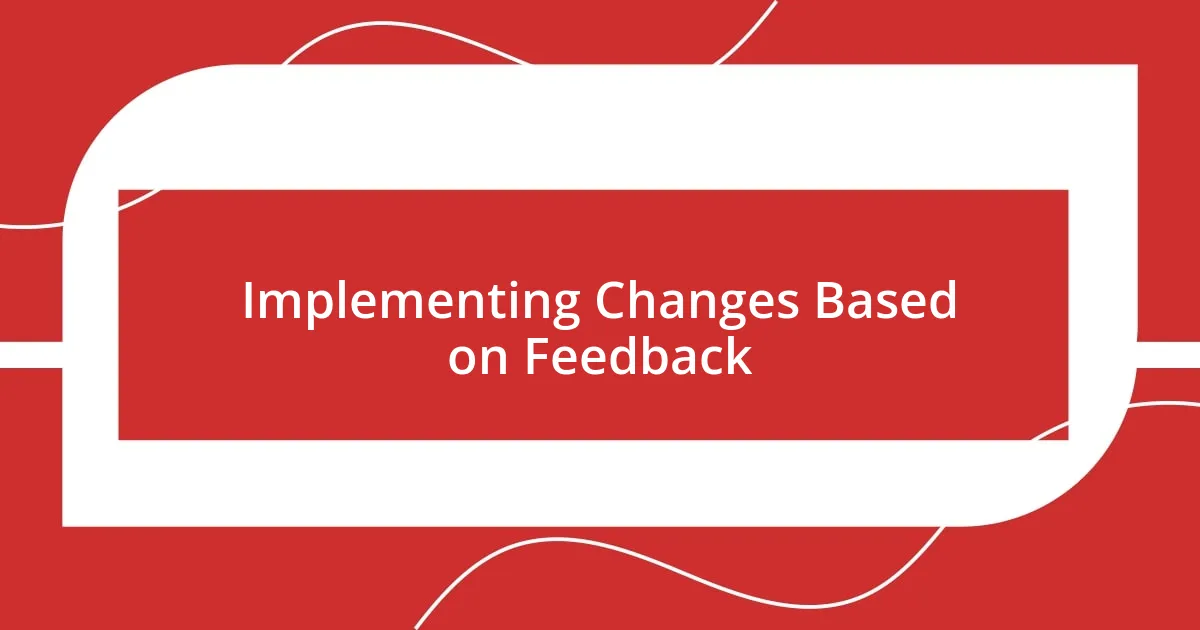Key takeaways:
- Feedback is essential for growth and fosters a sense of community among attendees, allowing for two-way communication.
- Effective feedback collection involves clear questions, timely requests, and a mix of quantitative and qualitative methods for deeper insights.
- Analyzing feedback should focus on identifying patterns and prioritizing key responses to inform actionable changes for future events.
- Continuous improvement stems from implementing feedback loops, encouraging ongoing dialogue, and fostering a culture of collaboration and engagement.

Understanding the Importance of Feedback
Feedback is a powerful tool that can shape our growth and decision-making. I remember the first time I received constructive criticism after organizing my first workshop. Initially, I felt defensive, but as I reflected on the feedback, I realized it held the key to improving the next event. How often do we dismiss feedback as mere criticism instead of an opportunity to elevate our efforts?
Understanding the importance of feedback also means recognizing that it fosters connection. When attendees share their thoughts, it shows they care about the experience, which creates a sense of community. Just think about a time when you expressed your thoughts on an event; didn’t it feel good to know your voice mattered? This two-way dialogue not only enhances the event but also makes everyone involved feel valued.
Moreover, feedback acts like a mirror, reflecting our strengths and areas for growth. I’ve seen firsthand how gathering insights after an event can reveal patterns I hadn’t noticed. Have you ever been surprised by the feedback you received? That surprise can be a catalyst for change, guiding us to refine our strategies and deliver even more impactful experiences in the future.

How to Gather Effective Feedback
When it comes to gathering effective feedback, I’ve found that clarity is key. Whether it’s through surveys or informal conversations, ensuring questions are straightforward can make a huge difference. For instance, after one of my events, I discovered that specific, open-ended questions prompted more detailed responses. I remember crafting a simple question, “What stood out to you the most?” It solicited a wealth of insights that shaped my future events significantly.
Timing also plays a crucial role. Asking for feedback immediately after an event ensures that impressions are fresh and vivid. I’ve personally sent out feedback forms right after my workshops, and the responses I gathered were richer and more reflective of attendees’ real experiences. Comparing that to waiting a week, I found that memories faded, and so did the quality of feedback. It made me appreciate the immediacy of acquiring that input when it matters most.
Lastly, using a combination of quantitative and qualitative methods is incredibly beneficial. I like to mix rating scales with open-ended questions. It offers both numerical data and personal stories. During my last event, I included a scale for participants to rate their experiences followed by a space for comments. The blend of metrics and personal anecdotes provided me with a fuller picture and actionable insights.
| Feedback Method | Benefits |
|---|---|
| Surveys | Structured, quantifiable data collection |
| Informal Conversations | Immediate, in-depth insights |
| Rating Scales | Easy to analyze trends |
| Open-Ended Questions | Rich, narrative feedback |

Analyzing Feedback for Actionable Insights
Analyzing feedback isn’t just about tallying numbers; it’s uncovering the underlying stories that drive those figures. I remember combing through responses after a particularly lively seminar. My heart raced as I found a common thread in attendees’ comments about the interactive activities. It struck me how these elements fostered engagement, and I felt a genuine sense of connection to the experiences shared. That moment of realization made me dig deeper into the nuances of the feedback.
To make the most of the insights gathered, I focus on several key strategies:
– Identify Patterns: Look for recurring themes that indicate what worked and what didn’t.
– Prioritize Feedback: Not all feedback is created equal; some responses will hold more weight in guiding your adjustments.
– Contextualize Responses: Consider the context behind feedback—sometimes a critical comment can stem from an unrelated source.
– Engage with Attendees: Reach out for clarification on complex feedback, turning it into a dialogue that can yield deeper understanding.
– Act on Insights: Create an action plan that addresses key takeaways to ensure improvements for future events.

Implementing Changes Based on Feedback
Implementing changes based on feedback requires a thoughtful approach. I recall a time when several attendees voiced their frustration about the event’s scheduling. Instead of dismissing that feedback, I took it to heart. I organized a roundtable discussion with a few participants to dive deeper into what would work better. It was enlightening! They appreciated being asked for their input, and it helped me redesign my future events for better timing and flow.
It’s vital to prioritize the feedback you receive, too. Last year, one participant suggested we reduce the number of sessions in favor of more in-depth discussions. At first, I hesitated. After examining the sentiment behind that feedback, it clicked for me. I realized that condensing sessions could encourage richer conversations and allow participants to connect more meaningfully. The change wasn’t just logical; it brought a fresh energy to the events, and I could see attendees engaging with one another in ways I hadn’t anticipated.
Finally, communication is key when implementing changes. After launching my redesigned event structure, I made it a point to share the feedback-driven improvements with my audience. I created a short video explaining the changes and how their voices shaped them. The responses were overwhelmingly positive. This kind of transparency not only shows appreciation but fosters a sense of community—attendees realize their opinions matter. So, have you considered how sharing these changes might enhance your connection with your participants? It’s a strategy I genuinely recommend!

Measuring the Impact of Changes
Measuring the impact of changes is often a revelation in itself. After implementing a new feedback-driven process at my events, I vividly recall standing in front of a new group of participants, feeling a mix of anticipation and excitement. Curiously, I asked how they felt about the adjustments made, and the responses flooded in—a mix of enthusiasm and constructive insights. It was in that moment I realized that successful measurement isn’t just numbers; it’s understanding the emotional landscape of your audience and how they perceive those changes.
I also learned that follow-up surveys can unveil deeper insights into the effectiveness of changes. For instance, after reducing session lengths based on previous feedback, I sent out a survey asking participants specifically about the new format. The depth of their responses surprised me. Many shared how the fresh structure not only kept their attention but also encouraged them to share their own insights more openly. Don’t you think tapping into that feedback loop can create a more connected community? It surely amplified my ability to tailor future events, driving a sense of shared ownership among attendees.
Furthermore, I’ve found that visible metrics—like engagement rates or audience retention—help quantify the changes’ success. After altering my content delivery style, I noticed a 25% increase in session participation over the next few events. This statistic wasn’t just a number to me; it embodied the shift in how participants were engaging with the content. It led me to wonder, what other changes could elicit such a positive reaction? Reflecting on this, I’ve become passionate about continuously measuring and adapting—not just for the numbers, but for the heartfelt connections it fosters.

Continuous Improvement from Feedback Loops
Continuous improvement thrives within effective feedback loops. I remember implementing a suggestion from an attendee who wondered why we didn’t offer networking sessions after events. Curious and a bit skeptical, I decided to try it out. The excitement in the room during that first networking event was palpable. Attendees were eager to connect, sharing their experiences and insights. It’s incredible how a single piece of feedback can ignite such enthusiasm and community spirit!
Building on that experience, I realized that feedback doesn’t just improve events; it cultivates relationships. During a follow-up chat, I asked participants how they felt about incorporating regular feedback sessions into our planning process. Their positive responses showed me that they appreciated having a voice, and many shared that they wanted to contribute even more actively. Do you see how this engagement can enhance your event’s atmosphere? I felt a renewed sense of responsibility—not just to listen, but to invite ongoing dialogue, making the whole process feel truly collaborative.
The beauty of feedback loops is that they create a culture of continuous improvement. Reflecting on past events, it struck me how a minor tweak in our format could lead to a significant shift in attendee satisfaction. There was one event where I experimented with interactive polling during sessions, and the energy in the room skyrocketed. Attendees felt more involved and invested. It made me think: how often do we overlook simple changes that could lead to profound outcomes? This ongoing journey of implementing feedback has taught me to embrace change as a constant companion on my event-planning path.















